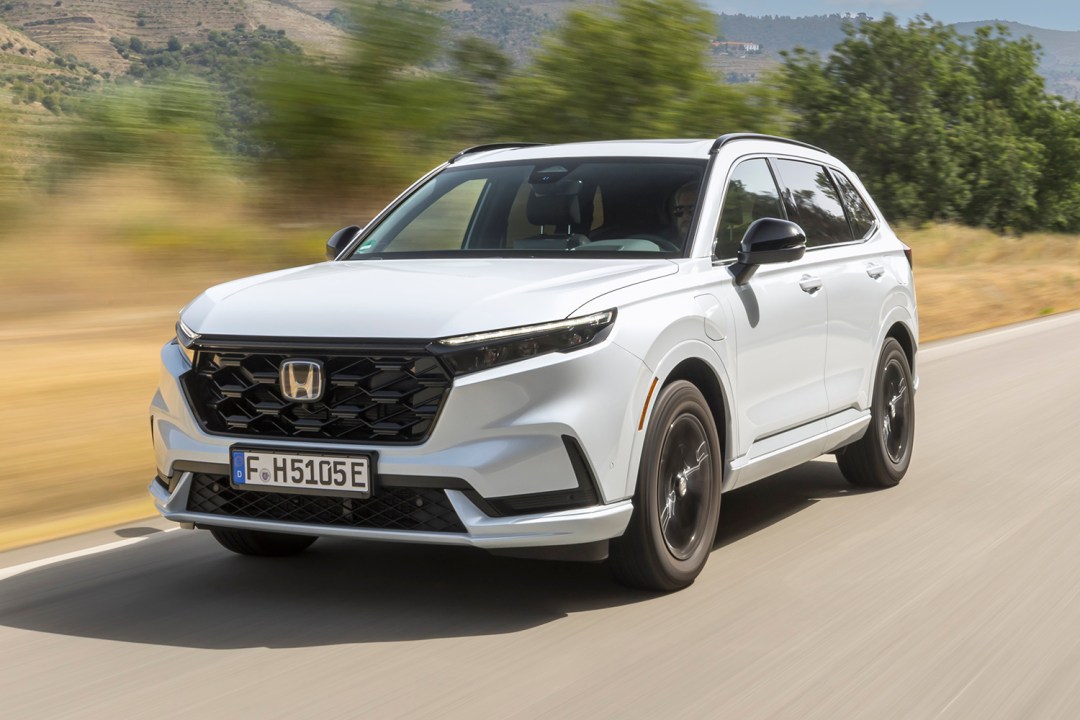Honda CR-V e:PHEV review – plug and go appeal
Sixth-gen CR-V delivers enduring appeal for conservative car types

Now in its sixth incarnation, the Honda CR-V is everything you’d expect from the Japanese carmaker. Its dependable charm, which made it such a big seller in the States, has been retained – even if those conservative design lines still don’t set the world on fire. You can have one with the same dependable hybrid setup as the latest Honda Civic, but it’s the plug-in CR-V e:PHEV that we think sounds most promising.
Volatile fuel prices and an economy to match means lots of folks want value for money from their motoring, so the promise of 51 miles of EV-only driving should be more than adequate for anyone who makes forays into their town centre for shopping excursions or wants to do the school run in silence.
The styling



There’s nothing revolutionary about the exterior of the new Honda CR-V and, for the most part, the shape is a standard and fairly by-numbers SUV. It is slightly wider, by just 10 millimetres and gets an extra 80 millimetres added to the overall length, with a wheelbase that has been extended by 40 millimetres compared to the outgoing CR-V. All models sit on nicely styled 18-inch alloys, which help add value to the look of the car. Considering its size though the CR-V e:PHEV doesn’t look or feel like a lump.
The front end has many of the same design touches found on the other new or revised models in the Honda range, including cool LED headlights, so it fits into the product portfolio quite nicely. Meanwhile, the cockpit is also very sensible and carries on trim themes that work so well in the latest Honda Civic. The vents, for example, which Honda engineers were so enthusiastic about at the Civic launch make another appearance here. The CR-V comes well appointed too and naturally everything feels like it’s been well put together.
The drive


You can get the latest CR-V in two hybrid versions or head for the e:PHEV plug in that you see here, complete with a 17.7kWh battery. The 2-litre engine is nicely matched to the bulk of the car and there’s the added benefit of EV only when you set off, plus up to 51 miles of all-electric pootling when it’s needed. There’s a dedicated button that allows you to choose this over the engine too, but obviously only if there’s enough charge on tap. Ordinarily, the e:PHEV does a neat line in managing the power dynamically between petrol engine and battery power.
While it’s quiet and surprisingly agile around town, if you head out onto the motorway then the petrol-powered part of the package requires a bit more coaxing to get the best from it. This is a large SUV, so Sport mode is required to really make it come alive. If you’re just in normal drive those gradients can seem steeper than you expected and require a little more pressure from your right foot. Nevertheless, the CR-V goes around corners in organised fashion and without too much in the way of roll. Impressive given its stature and the chunky rubber it rides on.
The technology



As you’d expect, Honda’s designers haven’t gone overboard with the CR-V e:PHEV’s interior tech, but there’s more than enough inside the cockpit to get everything done without too much fuss or bother. The 10.2in TFT screen in front of the steering wheel is nicely executed, though driver safety dings, dongs and supporting graphics can tend to grate.
Even more annoying is the way the blindspot camera flashes into action on the 9in central touchscreen as you make a turn while simultaneously making the map you’re following disappear. Turning it off seems to be the only realistic remedy to not getting lost if you’re on unfamiliar turf. The e:PHEV also boasts Honda’s Digital Key, which allows you to use an app for core operations, such as locking and unlocking the doors as well as turning on the engine.
One other pleasing feature is the addition of LED lighting for the interior, which is used to great effect in common areas such as the centre console, footwells and the door handle areas too. And while there is a decent pile of technology, Honda’s sensible designers have retained a decent level of physical controls too, for climate settings and the like. It’s a great balance between new and old school thinking.
Honda Civic e:PHEV verdict


This being a family-focused SUV, the Honda CR-V is going to be great for longer runs, with in the region of 500 miles or more possible with the petrol and battery combination working at optimum performance. The boot can hold a stack of stuff too, up to 586 litres in the PHEV thanks to the way the battery has been integrated. Equally though, it’s happy enough on those shorter runs where you can make use of the EV-only potential.
The biggest issue with the PHEV Honda CR-V is its hefty price. Granted, the SUV comes packed with an impressive list of features and it is well built, but many potential customers might end up going for the cheaper hybrid option, or even a Toyota bZ4X for that matter. Get yourself a Lexus NX meanwhile and you get the same thing only in a posher format. Nevertheless, when it’s not being pushed the CR-V is smooth and comfortable, which is probably going to be perfect for any existing CR-V devotees (for there are many) who want to update and luckily have the finances available to do it.
Stuff Says…
It’s physically big with a price tag to match, but Honda’s plug-in reworking of the CR-V is a success on most fronts.
Honda Civic e:PHEV technical specifications
| Powertrain | 2.0-litre petrol engine plus 135kW electric motor |
| Battery | 17.7kWh |
| Power | 181bhp |
| Torque | 247lb ft |
| 0-62mph | 9.4sec |
| Top speed | 116mph |
| Fuel efficiency | 42.2mpg, 51 miles EV-only |
| Charge rate | 6.8kW |
| Kerb weight | 1533kg |
| Cargo volume | 586 litres |
